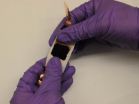(Press-News.org) This press release is available in German.
The mass ratio of protons and electrons is deemed to be a universal constant. And rightly so, as the latest radio-astronomy observations of a distant galaxy have shown. Scientists at the VU University of Amsterdam and the Max Planck Institute for Radio Astronomy in Bonn used the 100-metre radio telescope in Effelsberg to measure absorption lines of the methanol molecule at a number of characteristic frequencies. The researchers analysed the spectrum of the simplest of all the alcohols in a very distant galaxy. The result: to a high degree of accuracy molecules and molecular matter have the same properties today as they did seven billion years ago. According to this finding, the mass ratio of protons and electrons in particular has changed by less than one hundred thousandth of a percent in this period.
Measurements are the only way that physicists can find out about fundamental universal constants such as the proton-to-electron ratio. Although all terrestrial experiments produce the same value for this ratio, it would theoretically be possible for the constant to have a different value in different regions of the universe or at different times in its history. The methanol molecule is a suitable sensor for detecting such deviations.
A number of lines in the radio spectrum of this molecule would exhibit a significant frequency shift if the proton-to-electron mass ratio changed, while other lines would not be affected by this shift. A group at the VU University of Amsterdam only recently found out which property makes methanol such a sensitive sensor: ultimately it is a quantum tunnel effect which occurs if the internal rotation of the molecule is impeded. This effect leads to very high values for the sensitivity coefficients of the corresponding spectral lines, which can all be calculated individually.
"This makes the methanol molecule an ideal test case in order to discover a possible change in the proton-to-electron mass ratio over time," says Wim Ubachs, Professor at the VU University of Amsterdam and head of the physics department. "We therefore proposed a search for line radiation from methanol in the distant universe in order to compare the structure of the molecules thus found with the structure of today's methanol in laboratory experiments."
The team observed a galaxy where a number of different molecules had already been observed. The galaxy, which is in the line of sight of a high-intensity radio source called PKS1830-211, is about seven billion light years away from Earth. The scientists aimed for four different line transitions in the radio spectrum of the methanol molecule with their search program. And they were actually able to see all four lines with the aid of the 100-metre radio telescope in Effelsberg.
"As an optical astronomer it has been an interesting experience to carry out observations at the large wavelengths which occur in the radio range," says Julija Bagdonaite, doctoral student at the VU University of Amsterdam and lead author of the publication. "The methanol molecule had absorbed these radio waves seven billion years ago, and the waves have carried along its fingerprint from the distant past on their passage to Earth."
By analysing the quantum structure of the methanol molecule the researchers were able to deduce that two of its spectral lines which they observed at frequencies around 25 GHz were influenced hardly at all by a change in the proton-to-electron mass ratio. The other two lines reacted much more sensitively to a modification of this parameter.
"The source we investigated is by far the most suitable of all our observational objects for investigating the validity of our local physics even in very distant exotic environments," says Christian Henkel from the Max Planck Institute for Radio Astronomy. "It would be fantastic if we could find more sources of this type which we could use to look even further back into the past."
The scientists also included systematic effects of the observations in the evaluation of the data and thus obtained the following result: in the course of the past seven billion years the mass ratio of protons and electrons has changed by a factor of 10-7 at most and is therefore rightly deemed to be a universal constant. This result can definitely be interpreted to mean that the structure of the molecular matter as derived from spectral observations agrees very accurately with the structure seven billion years ago. Possible deviations amount to a mere one hundred thousandth of a percent or even less.
"If we were really to find deviations in this fundamental constant, we would have a problem with our understanding of the foundations of physics," concludes Karl Menten, Director at the Max Planck Institute for Radio Astronomy. "Most importantly, this would violate Einstein's equivalence principle, the cornerstone of the general theory of relativity."
INFORMATION:
Original publication:
Julija Bagdonaite, Paul Jansen, Christian Henkel, Hendrick L. Bethlem, Karl M. Menten, Wim Ubachs: A Stringent Limit on a Drifting Proton-to-electron Mass Ratio from Alcohol in the Early Universe, Science Express, December 13, 2012.
Physical constant passes the alcohol test
Fundamental properties of molecules have not changed during the past 7 billion years
2012-12-15
ELSE PRESS RELEASES FROM THIS DATE:
Study questions reasons for routine pelvic exams
2012-12-15
The pelvic exam, a standard part of a woman's gynecologic checkup, frequently is performed for reasons that are medically unjustified, according to the authors of a UCSF study that may lay the groundwork for future changes to medical practice.
The research shows that many physicians mistakenly believe the exam is important in screening for ovarian cancer. The study, which surveyed obstetricians and gynecologists around the country, also shows that doctors continue to perform the exam in part because women have come to expect it.
The article is currently published online ...
New findings on killer bacteria's defence
2012-12-15
Antibodies are key to the recognition and neutralisation of bacteria by our immune system. The most common antibodies have the shape of a Y, and the two prongs fasten to molecules that belong to the bacteria. The cells in the immune system recognise the shaft and can then attack the bacteria.
Since the 1960s, it has been known that certain bacteria have developed the ability to turn these antibodies around, which makes it more difficult for the immune system to identify them. These include streptococcus bacteria, sometimes referred to as 'killer bacteria', that cause ...
More casinos does not mean more gamblers
2012-12-15
Memo to casino operators: just because you build it doesn't mean they will come.
A new study out of the University of Iowa examined how casino growth in the state has influenced gambling by residents. The survey suggests that fewer Iowans gambled overall and also that fewer people have become addicted to gambling despite a recent spurt in gaming facilities. Casino gambling was introduced in Iowa in 1991. There are currently 21 casinos in Iowa, all but three licensed by the state. (The others are owned and operated by Native American tribes.)
The findings could affect ...
Doing the right thing when things go wrong
2012-12-15
ANN ARBOR, Mich. — The University of Michigan Health System doesn't claim to be perfect. But its response to medical errors, near-misses, unexpected clinical problems and unintended outcomes is a model for the nation that other hospitals can and should copy, according to a new paper in a prestigious health care journal.
The "Michigan Model" for handling these situations, and preventing them from happening again, has not only helped patients and medical staff alike – it has also helped UMHS go against the grain of the costly, combative "deny and defend" medical malpractice ...
Stretchable electronics
2012-12-15
Electronic devices become smaller, lighter, faster and more powerful with each passing year. Currently, however, electronics such as cell phones, tablets, laptops, etc., are rigid. But what if they could be made bendable or stretchy?
According to the University of Delaware's Bingqing Wei, stretchable electronics are the future of mobile electronics, leading giants such as IBM, Sony and Nokia to incorporate the technology into their products.
Beyond traditional electronics, potential stretchable applications include biomedical, wearable, portable and sensory devices, ...
Drug to treat opioid addiction poses risks for accidental exposure to children
2012-12-15
(SALT LAKE CITY)—Buprenorphine is a safe and effective drug for treating opioid addiction. But as the prescribed use of buprenorphine has dramatically increased in recent years, accidental exposure of children to the drug has risen sharply, placing them at risk for serious injury and in extremely rare cases even death, according to researchers at the Utah Poison Control Center (UPCC), U School of Medicine's Department of Family and Preventive Health, and the Utah Department of Health (UDOH).
In a study published Thursday, Dec. 13, 2012, by the U.S. Centers for Disease ...
NASA sees Tropical Cyclone Evan batter and drench Samoan Islands
2012-12-15
NASA's Tropical Rainfall Measuring Mission or TRMM satellite continues to provide rainfall and cloud height data on powerful Cyclone Evan as it crawls through the Samoan Islands with hurricane-force winds and heavy rains. NASA's TRMM satellite identified "hot towers" in the storm, hinting that it would continue to intensify.
On Dec. 14, American Samoa, Tonga and Fiji are all under warnings or alerts as Evan continues to move west. A gale warning is in effect for Tutuila and Aunuu. A high surf warning is in effect for all of American Samoa. A flash flood watch is in effect ...
In decision-making, it might be worth trusting your gut
2012-12-15
Turns out the trope is true: You should trust your gut -- as long as you're an expert. So says a new study from researchers at Rice University, George Mason University and Boston College.
"How expert someone is within a particular domain has a positive impact on their ability to make an accurate gut decision," said Rice's Erik Dane, lead author of a study published last month in the journal Organizational Behavior and Human Decision Processes. However, he added, "Even if you're an expert, intuitive decision-making is better for some types of tasks than others. Tasks that ...
Dreidel-like dislocations lead to remarkable properties
2012-12-15
HOUSTON – (Dec. 14, 2012) – A new material structure predicted at Rice University offers the tantalizing possibility of a signal path smaller than the nanowires for advanced electronics now under development at Rice and elsewhere.
Theoretical physicist Boris Yakobson and postdoctoral fellow Xiaolong Zou were investigating the atomic-scale properties of two-dimensional materials when they found to their surprise that a particular formation, a grain boundary in metal disulfides, creates a metallic – and therefore conducting – path only a fraction of a nanometer wide.
That's ...
We're all living longer, but longevity increases not benefitting everybody
2012-12-15
TORONTO, ON – Global lifespans have risen dramatically in the past 40 years, but the increased life expectancy is not benefitting everybody equally, say University of Toronto researchers. In particular, adult males from low- and middle-income countries are losing ground.
People are living longer on average than they were in 1970, and those extra years of life are being achieved at lower cost, the researchers, led by U of T Chemical Engineering PhD candidate Ryan Hum, say in a paper published in the open access science journal eLife this month.
However, the costs for ...
LAST 30 PRESS RELEASES:
Making lighter work of calculating fluid and heat flow
Normalizing blood sugar can halve heart attack risk
Lowering blood sugar cuts heart attack risk in people with prediabetes
Study links genetic variants to risk of blinding eye disease in premature infants
Non-opioid ‘pain sponge’ therapy halts cartilage degeneration and relieves chronic pain
AI can pick up cultural values by mimicking how kids learn
China’s ecological redlines offer fast track to 30 x 30 global conservation goal
Invisible indoor threats: emerging household contaminants and their growing risks to human health
Adding antibody treatment to chemo boosts outcomes for children with rare cancer
Germline pathogenic variants among women without a history of breast cancer
Tanning beds triple melanoma risk, potentially causing broad DNA damage
Unique bond identified as key to viral infection speed
Indoor tanning makes youthful skin much older on a genetic level
Mouse model sheds new light on the causes and potential solutions to human GI problems linked to muscular dystrophy
The Journal of Nuclear Medicine ahead-of-print tip sheet: December 12, 2025
Smarter tools for peering into the microscopic world
Applications open for funding to conduct research in the Kinsey Institute archives
Global measure underestimates the severity of food insecurity
Child survivors of critical illness are missing out on timely follow up care
Risk-based vs annual breast cancer screening / the WISDOM randomized clinical trial
University of Toronto launches Electric Vehicle Innovation Ontario to accelerate advanced EV technologies and build Canada’s innovation advantage
Early relapse predicts poor outcomes in aggressive blood cancer
American College of Lifestyle Medicine applauds two CMS models aligned with lifestyle medicine practice and reimbursement
Clinical trial finds cannabis use not a barrier to quitting nicotine vaping
Supplemental nutrition assistance program policies and food insecurity
Switching immune cells to “night mode” could limit damage after a heart attack, study suggests
URI-based Global RIghts Project report spotlights continued troubling trends in worldwide inhumane treatment
Neutrophils are less aggressive at night, explaining why nighttime heart attacks cause less damage than daytime events
Menopausal hormone therapy may not pose breast cancer risk for women with BRCA mutations
Mobile health tool may improve quality of life for adolescent and young adult breast cancer survivors
[Press-News.org] Physical constant passes the alcohol testFundamental properties of molecules have not changed during the past 7 billion years





